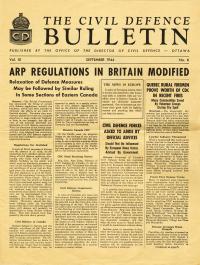Air Raid Precautions
Keeping Canada secure
As the enemy threat against Canada faded, civil defence workers turned their energies to other matters, including fighting forest fires and promoting mine safety.
Rehearsing for a blackout
Air raid drills and blackouts were a common feature of life in Canada during the Second World War - as this sign posted in a British Columbia hotel indicates.
Blackout for smaller shops and businesses
Part of a larger series, this booklet detailed the necessary steps in protecting small businesses from a potential air raid. Of particular importance was the various ways in which windows could be protected - either through improvised shades or the use of blackout paint.
Blackout for the home
Communities often relied on blackout techniques to conceal residential areas from enemy airmen. This booklet educated civilians on the regulations and procedures associated with preparing one's house both inside and out.
Be prepared for bombs
As the enemy developed new types of incendiary bombs, it was necessary to keep the public informed about new procedures - despite the fact that a fire raid on Halifax or Winnipeg was unlikely.
Guarding Canada against aerial attack
The Aircraft Detection Corps was made up of volunteers, each armed with binoculars and a handbook of aircraft silhouettes to aid in identification. Upon spotting an enemy aircraft, they were specifically requested to telephone the details to the authorities, rather than sending them through the mail.






